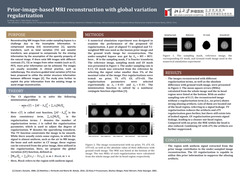Prior-image-based MRI reconstruction with global variation regularization
ID:90
Submission ID:96 View Protection:ATTENDEE
Updated Time:2021-10-30 22:03:44 Hits:1558
Poster Presentation

Start Time:2021-11-13 09:25 (Asia/Shanghai)
Duration:5min
Session:[Pos] Poster » [Pos] Poster Session
Video
No Permission
Presentation File
Tips: The file permissions under this presentation are only for participants. You have not logged in yet and cannot view it temporarily.
Abstract
Purpose:
Reconstructing MR images from under-sampling kspace is a challenge due to incomplete information. In compressed sensing (CS) reconstruction, sparsity transform, such as total variation (TV) and wavelet transform, was proposed to compensate for the missing information by the assumption of the sparsity property of the natural image. If there exist MR images with different contrasts (T1, T2) or images from other models (such as CT, PET), more prior information can be achieved. The images are usually accessible in clinical practice, such as radiotherapy. The structure-guided total variation (sTV) has been proposed to utilize similar structure information between different images. The study aims to further exploit the prior information from the existing image to assist image reconstruction. The CS algorithm is to solve a minimization problem. The TV function constraints the image to be smooth. While there usually exist some regions, in which the signal is almost uniform, such as air, these regions can be extracted from the prior image, then utilized in the regularization. Here, we propose the global variation (GV) function.
Methods:
A numerical simulation experiment was designed to examine the performance of the proposed GV. A pair of aligned T1-weighted and T2-weighted MR images were used as the known prior image and the ground truth image for reconstruction. The under-sampled kspace was got by a masked Fourier transform. The under-sampling rate is 0.13, GV mask was extracted from the reference by selecting the signal value smaller than 5% of the maximal value of the image. Five regularizations were tested: no prior, TV, sTV, GV, sTV+GV. The regularization parameters were selected experientially as 0.03. The minimization function is solved by a nonlinear conjugate function algorithm.
Results and discussions:
With an under-sampling rate of 0.13, the reconstructed image without a regularization term (i.e., no prior) shows strong aliasing artifacts. Lots of them are located out of the head region, referring to signal leakage. TV regularization reduces the artifacts and sTV regularization goes further, but there still exists lots of leaked signals. GV regularization prevents signal leakage, leading to a cleaner out-head region. Compared with no prior, the MSE within the head is also reduced. Combining GV with sTV, the artifacts are further suppressed.
Conclusions:
The region with a uniform signal extracted from the prior image contributes to the under-sampled image reconstruction. The GV regularization is capable to utilize this prior information to suppress the aliasing artifacts.
Reconstructing MR images from under-sampling kspace is a challenge due to incomplete information. In compressed sensing (CS) reconstruction, sparsity transform, such as total variation (TV) and wavelet transform, was proposed to compensate for the missing information by the assumption of the sparsity property of the natural image. If there exist MR images with different contrasts (T1, T2) or images from other models (such as CT, PET), more prior information can be achieved. The images are usually accessible in clinical practice, such as radiotherapy. The structure-guided total variation (sTV) has been proposed to utilize similar structure information between different images. The study aims to further exploit the prior information from the existing image to assist image reconstruction. The CS algorithm is to solve a minimization problem. The TV function constraints the image to be smooth. While there usually exist some regions, in which the signal is almost uniform, such as air, these regions can be extracted from the prior image, then utilized in the regularization. Here, we propose the global variation (GV) function.
Methods:
A numerical simulation experiment was designed to examine the performance of the proposed GV. A pair of aligned T1-weighted and T2-weighted MR images were used as the known prior image and the ground truth image for reconstruction. The under-sampled kspace was got by a masked Fourier transform. The under-sampling rate is 0.13, GV mask was extracted from the reference by selecting the signal value smaller than 5% of the maximal value of the image. Five regularizations were tested: no prior, TV, sTV, GV, sTV+GV. The regularization parameters were selected experientially as 0.03. The minimization function is solved by a nonlinear conjugate function algorithm.
Results and discussions:
With an under-sampling rate of 0.13, the reconstructed image without a regularization term (i.e., no prior) shows strong aliasing artifacts. Lots of them are located out of the head region, referring to signal leakage. TV regularization reduces the artifacts and sTV regularization goes further, but there still exists lots of leaked signals. GV regularization prevents signal leakage, leading to a cleaner out-head region. Compared with no prior, the MSE within the head is also reduced. Combining GV with sTV, the artifacts are further suppressed.
Conclusions:
The region with a uniform signal extracted from the prior image contributes to the under-sampled image reconstruction. The GV regularization is capable to utilize this prior information to suppress the aliasing artifacts.
Keywords
fast MRI, regularization, prior image
Speaker

飞 王
北京大学肿瘤医院Submission Author
All comments
Countdown
-
00
Days
-
00
Hours
-
00
Minutes
-
00
Seconds
Important Dates
| Abstract submission date: |
2021-10-25 |
| Full paper submission date: |
2021-10-25 |
| Notification of acceptance date: |
2021-11-01 |
| Conference date: | 2021-11-12~2021-11-14 |
Contact Us
| Jinying Yang | +86 13675518597 |
| Debo Zhi | +86 15056085235 |
| Song Gao | +86 13121880288 |
| Le Cao | +86 15910809908 |
Comment submit